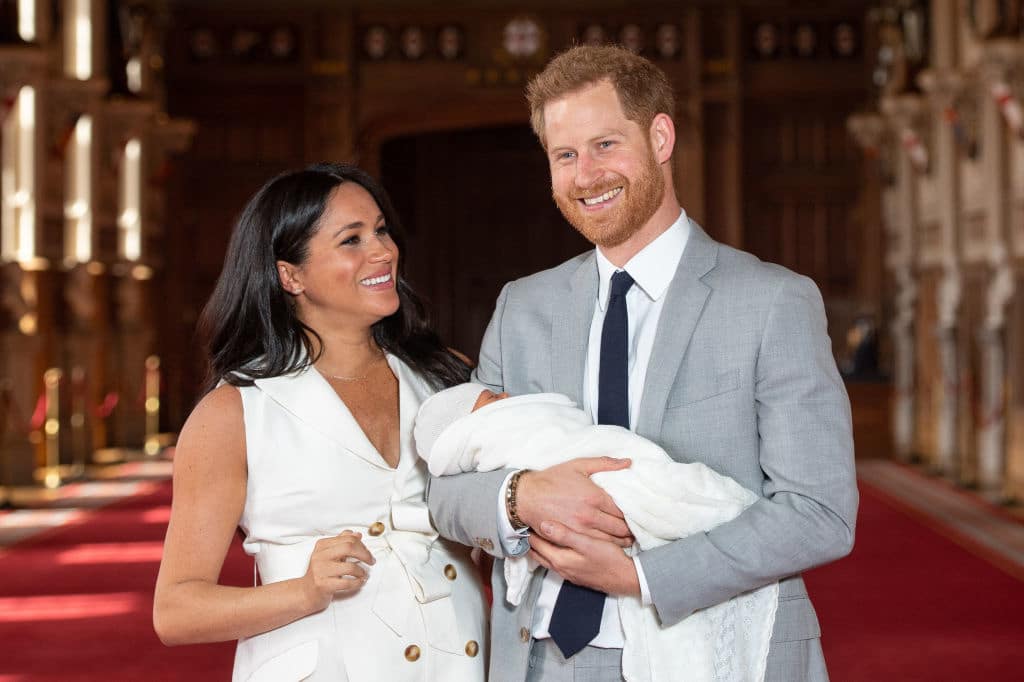Yes, Megan Markle still looks pregnant—here’s why

Let's take a moment to appreciate how extraordinary women's bodies are.
Table of Contents
We are so thrilled for the Duke and Duchess of Sussex as they welcome their first baby, and the newest addition to the royal family we love.
The internet is, of course, abuzz: everyone’s love of Megan Markle, Harry’s adorable announcement, and sweet baby Archie’s name revelation. And lots of people are focusing on Megan Markle’s body—specifically that she still looks pregnant.
While generally speaking, it’s best not to comment on women’s bodies, and to remember that despite her fame Megan Markle is a person who deserves privacy and respect, this does bring an important concept to light, that will hopefully help women feel more supported and empowered after giving birth.
Yes, you still look pregnant after you give birth.
Here’s why:
First, a quick overview of anatomy and birth
The uterus is a (fabulously amazing) hollow organ, made of muscles. Before pregnancy, the uterus sits nestled into the pelvis and is about the size of a fist (three or four inches long). When pregnancy happens (yay!), the embryo (aka tiny soon-to-be-baby) implants into the uterus, which then houses the baby throughout pregnancy.

Motherly
In order to do this, the uterus grows… a lot. In fact, it is believed that the volume of the uterus increases by, wait for it, 500 times during pregnancy. (Side note: Yes you DO deserve that serving of pie.)

Motherly
During labor, the uterus contracts, much in the same way that your bicep contracts when you make a muscle. Rhythmic contractions soften, thin (efface), and open (dilate) the cervix—the opening of the uterus. When the cervix is fully dilated, the contractions along with the woman’s effort of pushing, work together to bring the baby into the world. Yay!
During a Cesarean section, the baby is born via an incision that is made in the uterus.
What happens after birth
Despite all the hard work it has just done, the uterus still has much to do after the baby is born. It must give birth to the placenta and then it must do the Herculean task of healing.
Healing from birth (vaginal and Cesarean) means a few things:
- Bleeding. The placenta grows on the uterine lining, and when it detaches at birth, there is essentially a fairly large wound inside the uterus that now needs to heal. Women often have period-like bleeding for a few days, followed by lighter red flow, then pinkish brown, then white, and finally clear. This can last anywhere from two to six weeks. (Important note: If you are postpartum and bleed heavily, filling a pad in an hour or two or pass a clot larger than a golf ball, seek medical attention right away.)
- Involution. Involution is the process by which the uterus “shrinks” back down to its pre-pregnancy size. It does this by contracting (again). If you have breastfed a newborn, you likely felt some cramping when the baby latched those first days. This is because your body releases oxytocin (the love and contractions generating hormone) every time you nurse, which then, in turn, makes the uterus contract. This was very intentional on Mother Nature’s part because this decreases your risk of bleeding too much.
The shrinking of the uterus, involution, takes about six weeks. And this is why Megan Markle—and every woman ever—still looks pregnant after giving birth.
If you’ve given birth recently, you can lay on your back and feel the top of your uterus (this is called your fundus). Immediately after birth, the top of the uterus is at the level of your belly button, and then it will lower about one centimeter a day during pregnancy.
But again, this is when you are laying down.
When you stand up, it looks entirely different. Hence still looking pregnant.
The uterus spent the last nine months—280 days—getting bigger (and more awesome). In order to do this, it’s needed the support of the rest of the body, which stretched, shifted and, yes, gained some extra pounds. It is going to take time for all of those changes to reverse.
Also, in order to accommodate the growing uterus, the abdominal muscles usually separate to some extent—this is called diastasis recti. Normally, those muscles form the barrier wall between the organs and the outside world. But because they have been stretched and separated, they are not able to “hold back” the uterus (which remember, is still big). The bump may not have a baby in it anymore, but it is definitely still a bump.
The extent to which the postpartum bump lasts depends on a few factors: what number baby this is (it tends to be more exaggerated with each pregnancy because everything’s been stretched out before), pre-existing strength of the abdominal muscles, and body type in general.
Generally speaking, we don’t recommend getting back into an exercise routine until about the six or eight-week post-birth mark, but some fitness experts can work with you on some simple and safe ways to rehab your core before then.
If your diastasis recti is significant, your provider may recommend physical therapy. But be sure to discuss this with them first.
So, here are the takeaways:
- Congratulation, Megan and Harry!
- Let’s try not to focus on Megan’s (or anyone’s for that matter) body too much as she goes through this very normal process.
- It is really important that we change the message that is pervasive in our culture right now: Pop out the baby then bounce back quickly. Growing and giving birth to a human is a massive undertaking. The body (and mind) needs a significant amount of time, nurturing, and patience to heal.
Let’s shift this together, and appreciate women’s bodies for the extraordinary things that they are.


































